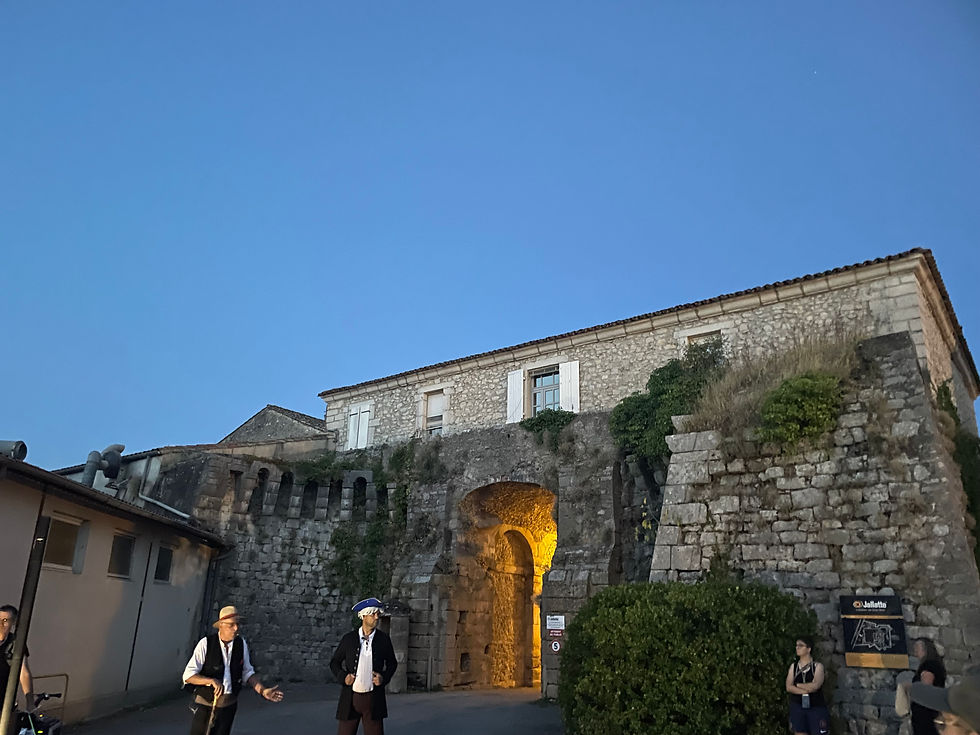A Museum of Silk
- JanetJoanouWeiner

- Apr 23, 2022
- 3 min read
Surprise! Our tiny little town has a museum. It’s small but nicely done and follows the history of the significant silk industry in our region.
As early as the 13th century, nearly every family raised silkworms throughout the Languedoc, and particularly the Cévennes. After rearing the worms, they prepared the silk thread and sold it to traders, who then sold it to weavers. It wasn't colorful as in this photo, but a beige-ish gray tint. In fact, raw silk is called "grège" in French, a nice mash-up of gray and beige.

By the 19th century, the silk manufacturing industry here had grown enormously and production moved into larger enterprises and factories.
Let’s take a tour of silk-related sights throughout St. Hippolyte du Fort and the museum.
Throughout the Cévennes, and of course here in St. Hippolyte, there are grand buildings that at one time consecrated the entire top floor to raising silkworms. As we searched for a place to live years ago, we visited several such magnaneries as they were called. Telltale signs include narrow windows just under the roof, smoke stains rising on the inside walls from warming fires, and the remnants of wooden structures where the silkworms grew and spun their cocoons.

At the height of silk production here, many noble mansions added a top floor magnanerie to profit from the lucrative industry. The windows in these buildings are often round and called "oeil de boeuf" or cow's eyes.

On a street around the corner from my home, we find this plaque on a building where Louis Pasteur stayed in 1869 to research a disease wiping out the silkworms. He, true to form, found the cure and saved the day. Today, the street is named––surprise!––"rue Pasteur."

Mulberry trees, providing the silkworms’ main diet, had grown here since the 16th century, when the King of France encouraged silk production within his kingdom. There are still quite a few white mulberries around; at one time, they were called the “golden trees” of the Cévennes. What is now the central area of our town was at one time a grove of these necessary trees.




In a recent post, I wrote about the voie verte, the walking path through our town and beyond built on the old railroad tracks. The train route here was important for exporting the local silk to large cities. It also brought loads of coal needed to run the silk spinning factories that had sprung up throughout the region.

From silkworms to silk thread, to woven cloth...what then? Silk fabric was used for all manner of beautiful clothing. Here are some surprising statistics for the fabrication of one silk shirt:
300 grams of silk thread
400 grams of raw silk
2 kilograms of cocoons
1000 cocoons
1000 silkworms
40 kilograms of mulberry leaves
2-3 mulberry trees
Also, one silkworm can secrete a thread measuring up to 1.5 kilometers! Wow!
Sadly, in the mid-19th century, the silk industry reached its peak by the inhumane labor of women and girls as young as nine-years-old. These workers staffed silk-spinning factories for meager wages (3 days = 1 kilo of potatoes) and 12-14 hour workdays, every day except Sunday. It’s hard to imagine such work conditions today, including plunging their hands in boiling water to extract cocoons.


Our local elementary school was once a filature, silk and stocking factory. One worker, Rachel Cabane, started at the tender age of nine. Years later, she was one of the first to organize women into unions demanding better working conditions and pay. Today they've named the school in her honor.

Now, let's go into the Silk Museum. One of the rooms recreates a silkworm farm, with a scaffolding of tables and racks where the little guys grew.


Another manner to facilitate cocoons was in dried heather branches:

There's also a room dedicated to spinning––the manufacture of silk thread from cocoons.

Also, we have equipment used for weaving and knitting. This giant warping machine, used to create warp threads later transferred to a loom, is fascinating.
There are also several types of knitting machines.


At the height of the French silk industry, the Cévennes became known for fabricating gorgeous silk stockings. These incredible creations dressed the calves of royal courts throughout Europe.


Our little museum tour ends with some lovely dresses. My favorite is this white one; I love the train and can just imagine Sunday strolling through the park, parasol in hand, my beau on my arm.


I love how God made us in his image, as creative beings. At a moment in time, someone, somewhere, looked at little worms, making cocoons, and had the thought of unraveling them into silken threads. And from there, dyed and woven into luxurious fabric, etc. Wow!
La vie est belle!
Here's a very short, lovely little video...








Fascinating!! Thank you for posting this Janet 💗